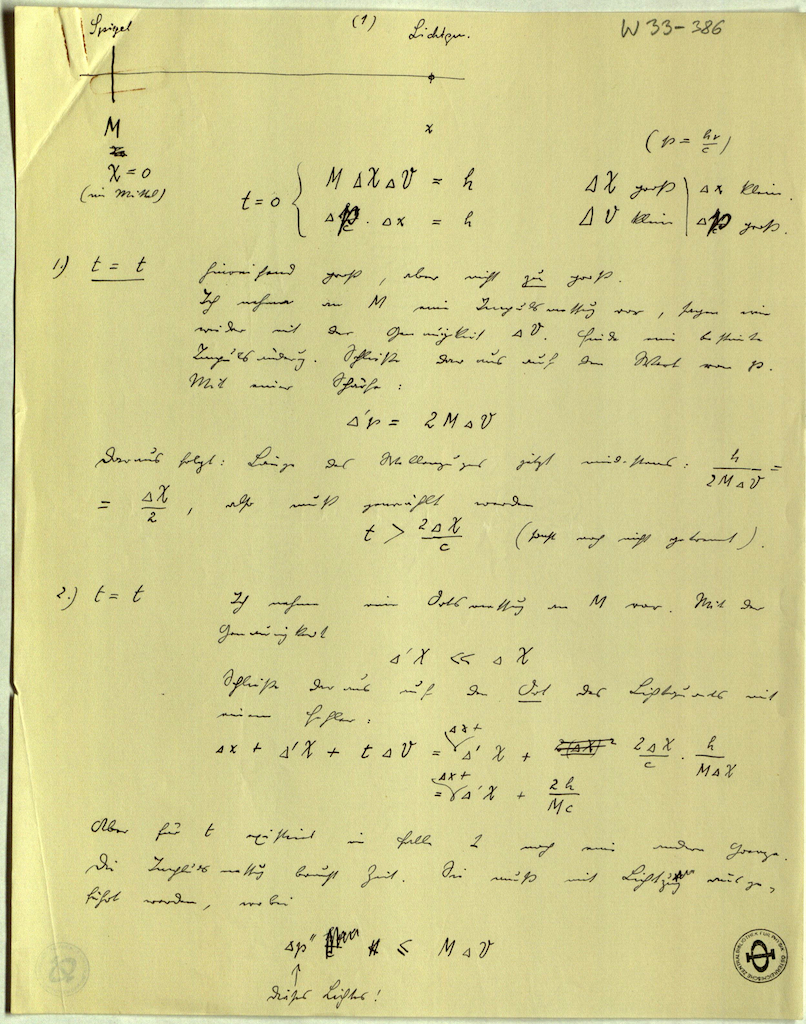
Since his student days, Erwin Schrödinger wrote extensive research notes, which are now held in the Austrian Central Library for Physics in Vienna. They are a unique resource for the history of modern physics, since Schrödinger wrote down his thought processes, doubts and hopes in explicit and lucid prose, unlike most of his colleagues. Like his publications, the notes are written in an elegant and sophisticated style, reminding the reader of Robert Musil in the irony and modernity of their language. But more importantly, the notes offer an immediate and unfiltered view of the creative process of a theoretical physicist, unlike publications, correspondence, and even later memory, which usually present a version that is reworked according to successive clarifications and argumentative strategies.
Given Schrödinger’s eminent position in the history of twentieth century physics, it seems surprising that these notes have not been used more extensively in historical research, but there are several factors that have hindered their use as a resource for historians. They are written in traditional German script, not easy to decipher even for modern German readers; some passages are even in Gabelsberger shorthand, a traditional German stenography which has not been taught for a hundred years. The notes are organized thematically and hardly ever dated, so it is not trivial to find relevant passages in the sheer amount of material available. Lastly, only recently they have become easily accessible from anywhere through an exemplary digitization project of the library.
As just one example of the discoveries that can be made in the notebooks, I will consider some recently found materials, which throw a new light on two papers that play an important role for modern research in quantum physics and especially the work of the IQOQI: In the year 1935, Einstein, Podolsky and Rosen proposed their famous thought experiment (commonly abbreviated as EPR), which they claimed could prove the incompleteness of quantum mechanics [Einstein, Podolsky et al. 1935]. In the same year, Schrödinger responded with a publication [Schrödinger 1935] that put EPR’s argument in a wider theoretical context, not only introducing his equally famous cat but also coining the term ‘entanglement’ (Verschränkung) for the feature of quantum mechanics that EPR had exploited and which has since been recognized as absolutely central for the nonclassical character of quantum mechanics. Unlike Einstein, Schrödinger was not confident that the paradoxical result of EPR could be remedied by some kind of completion of quantum mechanics by an underlying theory, offering very interesting arguments against the existence of hidden variables, that were confirmed by the later work of John Bell.
Both Einstein and Schrödinger had pointed out the problems to give a consistent physical interpretation of quantum mechanics in the early debates after the establishment of quantum mechanics in 1926. Nevertheless, it has been quite unclear how their thought had developed since then and where the novel arguments of the 1935 papers came from. There is a hint in the correspondence of Einstein and Schrödinger that these papers have a longer prehistory. In a letter to Einstein right after the publication of EPR, Schrödinger mentions that “already back in Berlin” (i.e. before they both fled the Nazis in 1933) they had had heated discussions about this problem. The historian and philosopher of physics Don Howard had pointed out [Howard 1990] that a plausible candidate for these discussions could be connected to a talk that Einstein gave on Nov. 4, 1931 about the so-called photon box thought experiment, a thought experiment that Einstein never published but that got popularized through Bohr’s account.
Indeed, in Schrödinger’s notes there is a manuscript, which for once is dated, carrying the date of Nov 4, 1931, part of two folders entitled “Szilard Spiegelversuch” (Szilard Mirror Experiment). From this manuscript it becomes evident that after Einstein’s talk Leo Szilard proposed a different thought experiment in which a photon gets reflected off a heavy mirror. Szilard argued that—with the appropriate initial conditions—measurements on the mirror could be used to measure either position or momentum of the photon with in principle unlimited precision, without ever interacting with the photon. This is in apparent conflict with the uncertainty relations, which say that complementary quantities can never both be measured without a minimum uncertainty. Even though this is true in this case also, since the two measurements on the mirror are complementary, and so cannot be both performed, the fact that there is no interaction between the mirror and the photon anymore suggests that the found values of position and momentum must have existed independently before.
It is quite obvious that Szilard’s thought experiment is a direct precursor of the EPR situation, both use an entangled state of two systems in which both position and momentum are highly correlated even though neither subsystem has definite position or momentum. Indeed, Schrödinger even writes down an explicit quantum mechanical state that is very close to the one EPR will use and notes that Szilard gave it to him to disprove Schrödinger’s original suspicion that uncertainties of observables in a composite system always have to be larger than the uncertainties of its parts, making the claimed precision impossible. Schrödinger spent considerable time analyzing this state, which is more general than the EPR state, and a lot of his insights were published in the 1935 paper. Therefore, there can be hardly any doubt that this is the discussion that Schrödinger remembered in 1935, and that the original idea for the EPR paper goes back to Szilard’s example.
References and further reading
Einstein, A., et al. (1935). "Can Quantum Mechanical Description of Reality Be Considered Complete?" Physical Review 47: 777–780.
Howard, D. (1990). Nicht sein kann was nicht sein darf: Or the Prehistory of EPR, 1909–1935: Einstein’s Early Worries about the Quantum Mechanics of Composive Systems. Sixty-two Years of Uncertainty: Historical, Philosophical, Physics Inquiries into the Foundations of Quantum Physics. A. I. Miller. New York, Plenum: 61–111.
Schrödinger, E. (1935). "Die gegenwärtige Situation in der Quantenmechanik." Die Naturwissenschaften 23: 807–812; 823–828; 844–849.

